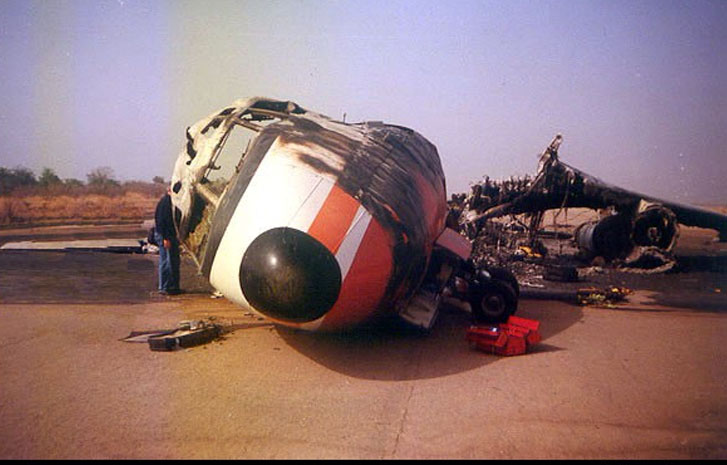The Accident Investigation Bureau (AIB) on Tuesday said that the accident involving a BOEING 737-282 aircraft operated by defunct Chanchangi airlines in 2008, was as a result of “unstabilised approach”.
AIB Commissioner, Mr Akin Olateru, made this known in Abuja during a news conference on the release of four occurrence reports.
According to him, the accident involving BOEING 737-282 aircraft with registration marks 5N-BIG occurred at Port- Harcourt International Airport, on July 14, 2008.
“The causal factor is the decision to land following an unstabilised approach (high rate of descent and high approach speed). A go-around was not initiated.
“The contributing factors are the deteriorating weather conditions with a line squall preventing a diversion to the alternate routes and the runway was wet with significant patches of standing water.
“In view of the issuance of the Nigeria CAR 2009 and the revision in 2015, which addressed the areas of shortcomings identified in this investigation, no safety recommendations are made,” he said.
READ ALSO: PDP attacks el-Rufai, accuses APC of frustrating restructuring calls
Olateru also spoke on the accident involving a BOEING 747-200 aircraft operated by Veneran Avia Airlines Ltd, which occurred at Nnamdi Azikiwe International Airport, Abuja on Dec. 4, 2013.
“The contributory factors included lack of briefing by Saudia dispatcher during pre-flight, runway status was missing from Abuja ATIS information, ineffective communication between crew and ATC on short finals.
“ Others are the runway markings and lighting not depicting the displaced threshold and the entire runway lighting was “ON“ beyond the displaced threshold,” it said.
According to him, AIB recommended that the Nigerian Airspace Management Agency (NAMA) should capture all essential information on the Automatic Terminal Information Services (ATIS).
He further said that the Federal Airports Authority of Nigeria (FAAN) should ensure that light at any displaced portion of the runway is switched off so as not to mislead any arriving/landing traffic.
“FAAN should ensure that runway obstruction, and/or runway displaced thresholds are marked/lit in accordance with DNAA Airside Operations Manual and Aerodrome Manual sections 4.10.7a and 4.13.3.4 respectively and communicated on time through NOTAMs to stakeholders.
“Veteran Avia should ensure that its operations are in conformity with the approved procedures established in accordance with company manuals,” it further said.
The commissioner said that the accident involving Beechcraft C90 Aircraft with national and registration marks N364 UZ operated by Shoreline Energy limited was as a result of the inability of the pilot to control the aircraft to landing.
He further said that the incident that occurred at Barakallahu village near old Kaduna (Military) Airport on May 24, 2011, was also due to inadequate power to enable the pilot to maintain the appropriate approach profile (height, speed and glide path) to cover the required distance to threshold.
“ Contributing factors included non-adherence to approved storage procedure, non-adherence to approved return from storage procedure and inadequate regulatory oversight by the authority on flight operation and maintenance of foreign registered aircraft in Nigeria.
“The recommendations are that the Nigeria Civil Aviation Authority (NCAA) should increase safety oversight on foreign-registered general aviation aircraft operating in Nigerian airspace.
“NCAA should promulgate detailed regulations/requirements on private category aircraft operations.
“NCAA should liaise with the old Kaduna (Military) Airport authorities to ensure that 1000M beyond RWY 23 should be easily accessible in accordance with internationally accepted standard stipulated in ICAO Annex 14.
“NCAA should liaise with the old Kaduna (Military) Airport authorities to ensure that an Airport Emergency Plan (AEP) is developed and maintained in line with Nig. CARs Part 12 (Aerodrome Regulations),” he said.
According to him, the accident involving TAMPICO TB-9 aircraft owned and operated by Nigerian College of Aviation Technology (NCAT) was as a result of late decision to initiate a go-around after touchdown.
He further said that the decision to initiate a go-around touchdown by TAMPIC TB-9 with nationality and registration marks 5N-CBJ resulted in the loss of directional control of the aircraft after landing at Zaria Aerodrome, Kaduna State, on Sept.26, 2018.
“Contributing factors included inappropriate control inputs during the landing roll and intermittent interruptions in training programmes.
“Safety recommendation made was that NCAA should ensure policies and procedures be put in place where there were gaps in the training programme so that students are brought up to speed in both theory and practice,” he said.



Leave a Reply